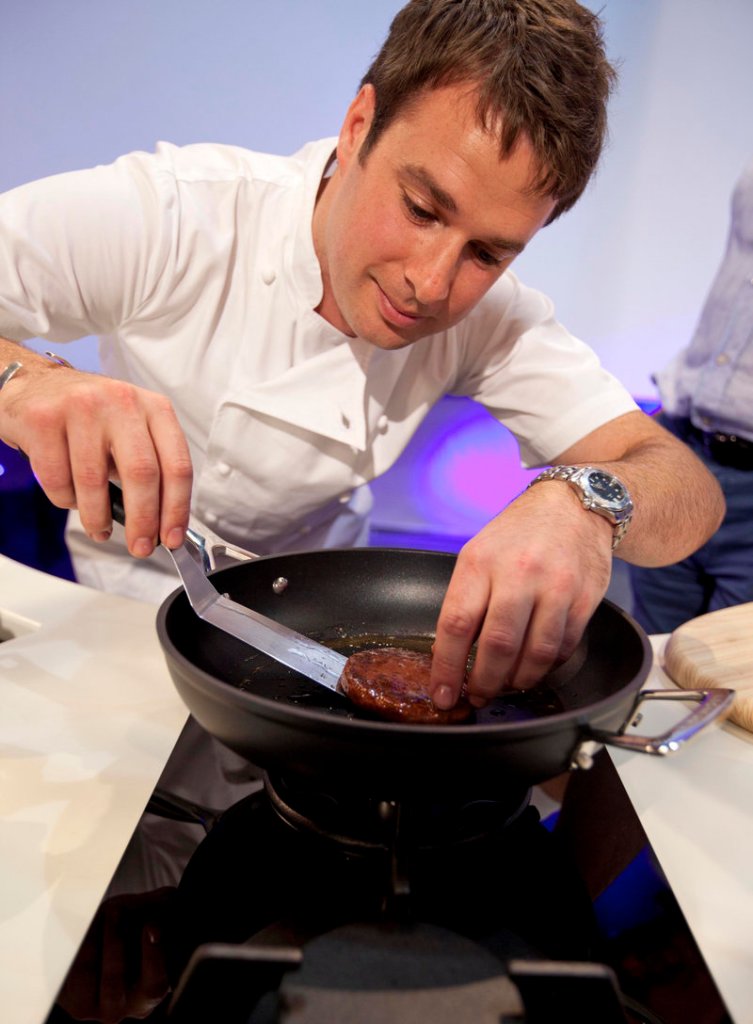LONDON — It looked like a burger. It smelled like a burger. It tasted, well, almost like a burger.
The first ever lab-grown beef hamburger was cooked and eaten in London on Monday. “We proved it’s possible,” said scientist Mark Post, who created the cultured minced meat in his lab at Maastricht University in the Netherlands.
The scene in Riverside Studios in West London, where the event took place, looked like something you might see on a TV cooking show: There was a fake kitchen counter, a tiny sink, a single burner and a chef, of course.
The 5-ounce burger patty — which cost over $330,000 to produce and was paid for by Google co-founder Sergey Brin — arrived under a silver dome and was promptly put onto a pan to sizzle with a good dab of butter and a splash of sunflower oil. The smells that drifted off toward the public (a few invited journalists and scientists) were subtle but unmistakably meaty.
Next came the tasting. Besides Post, only two people were allowed to have a bite of the test-tube burger: Josh Schonwald, the American author of “The Taste of Tomorrow,” and Hanni Rutzler, an Austrian nutritional scientist. Both said the burger tasted “almost” like a conventional one.
Rutzler gave the chef an appreciative nod. “It’s close to meat, but it’s not as juicy,” she said. “I was expecting the texture to be more soft. The surface was surprisingly crunchy.” She added: “I would have said if it was disgusting.” Schonwald said the product tasted like “an animal protein cake.”
Although the burger was a culmination of a five-year research project, it took Post only three months to grow it, using stem cells harvested from a cow’s shoulder. “That’s faster than (raising) a cow,” he said. The type of stem cells Post used, called satellite cells, are responsible for muscle regeneration after injury.
Peter Verstrate, a Dutch food technician who worked with Post on development of the burger, said people react badly when they hear the words stem cells. But “we don’t eat stem-cells, we eat muscles,” he said.
The cells were placed in a bioreactor in a nutrient mixture that helps them proliferate. There they grew into thin, 0.02 inch strands of muscle fiber — about 20,000 of those were used to create the burger presented in London.
Post said lab-cultured meat not only could help feed the planet, but could also help solve environmental problems stemming from conventional meat production.
And Boston University’s Joan Salge Blake, author of “Nutrition & You,” believes it has a potential to be healthier than conventional meat. “If they replace the saturated fats with omega-3 fats, that would be great for our health,” she said.
Copy the Story Link
Send questions/comments to the editors.



Success. Please wait for the page to reload. If the page does not reload within 5 seconds, please refresh the page.
Enter your email and password to access comments.
Hi, to comment on stories you must . This profile is in addition to your subscription and website login.
Already have a commenting profile? .
Invalid username/password.
Please check your email to confirm and complete your registration.
Only subscribers are eligible to post comments. Please subscribe or login first for digital access. Here’s why.
Use the form below to reset your password. When you've submitted your account email, we will send an email with a reset code.